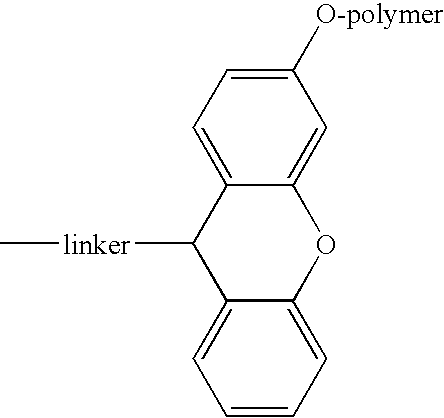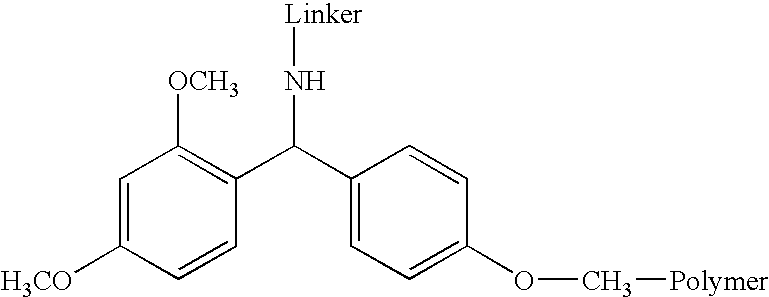Acid-labile isotope-coded extractant (ALICE) and its use in quantitative mass spectrometric analysis of protein mixtures
a technology of isotope-coded extractants and acid-labile isotopes, which is applied in the field of high-throughput quantitative protein analysis, can solve the problems of complex downstream data analysis, inability to readily elute captured peptides, and intrinsic limitations, and achieves the effect of increasing the dynamic range and sensitivity of quantitation and identification, and being easy to purify
- Summary
- Abstract
- Description
- Claims
- Application Information
AI Technical Summary
Benefits of technology
Problems solved by technology
Method used
Image
Examples
example 1
Synthesis of the Compound of the Invention
A. Preparation of Linker and Affinity Tag
[0048]A solution of maleic anhydride (0.98 g, 10.0 mmol in 15 ml of acetic acid) was added to a solution of 6-aminocaproic acid (1.31 g, 10 mmol in 5 ml of acetic acid). The resulting mixture was stirred at room temperature for two hours. After two hours, the mixture was heated to reflux (oil bath temperature about 110–120° C.) for four and a half hours. The acetic acid was removed in vacuum and 3.3 g of a light yellow solid was obtained. This solid was chromatographed (20% ethyl acetate in hexanes, then 50% ethyl acetate in hexanes) and gave 0.92 g of pure target compound (6-(2,5-dioxo-2,5-dihydro-pyrrol-1-yl)-hexanoic acid; 43% yield). This reaction is illustrated in the scheme provided below, in which acetic acid is abbreviated as HOAc.
[0049]
B. Preparation of Resin
[0050]The protected polymer, purchased commercially as NovaSyn TG Seiber resin (1 g, 0.15 mmol / g) was stirred in N,N-dimethylformamide (...
example 2
[0055]The present invention was carried out utilizing techniques and instrumentation known to those of skill in the art combined with a novel method of using the same. Specifically, data was obtained using automated LC / MS alone as well as using a novel automated 2-dimensional LC / LC / MS system using instrumentation available in the art. These instruments and methods of using the same are described below.
A. Automated LC / MS
[0056]Automated LC / MS was accomplished using a LC / MS MicroMass Q-ToF2 mass spectrometer (Micromass, Manchester, UK) equipped with an ABI 140 C. microgradient syringe pump system (Applied Biosystems, Framingham, Mass.). The sample was injected onto a strong cation exchange (SCX) column, a 100 μm×6 cm IntegraFrit column (New Objectives, Woburn, Mass.) packed with PolySULFOETHYL A, 12 μm, 300 Å (PolyLC Inc., Columbia, Md.). The sample was then eluted onto a RP-C18 column, a 75 μm×10 cm PicoFrit column (New Objectives, Woburn, Mass.) packed with YMC-Gel 10 ...
example 3
Preparation of Proteomes for MS Analysis
[0059]2 mg of bovine serum albumin (BSA) were solubilized in 200 μL of 8 M urea, 200 mM ammonium bicarbonate, and 20 mM CaCl2. 5 μmole of tributyl phosphine (TBP) pre-dissolved in 20 μL of acetonitrile (ACN) was added into the solubilized protein mixture and the resulting solution was incubated at 37° C. for one hour. To the protein mixture was added 11 μmoles of MMTS and the mixture was vortexed for 10 minutes. The protein solution was diluted 1:1 with 100 mM ammonium bicarbonate and 40 μg of Lys-C (2% w / w) were added. This mixture was then incubated at 37° C. for 5 hours. The resulting solution was diluted 1:1 with water and then proteins were further digested with trypsin (2% w / w) at 37° C. for 15 hours. The resulting peptide solution was dried and then reconstituted with 50% acetonitrile / 200 mM sodium phosphate (pH 7.2). Disulfide bonds on the cysteine-containing peptides were reduced with TBP (5 μmoles) at 37° C. for one hour. Then 50 mg ...
PUM
| Property | Measurement | Unit |
|---|---|---|
| molecular weight | aaaaa | aaaaa |
| molecular weight | aaaaa | aaaaa |
| pH | aaaaa | aaaaa |
Abstract
Description
Claims
Application Information
 Login to View More
Login to View More - R&D
- Intellectual Property
- Life Sciences
- Materials
- Tech Scout
- Unparalleled Data Quality
- Higher Quality Content
- 60% Fewer Hallucinations
Browse by: Latest US Patents, China's latest patents, Technical Efficacy Thesaurus, Application Domain, Technology Topic, Popular Technical Reports.
© 2025 PatSnap. All rights reserved.Legal|Privacy policy|Modern Slavery Act Transparency Statement|Sitemap|About US| Contact US: help@patsnap.com



